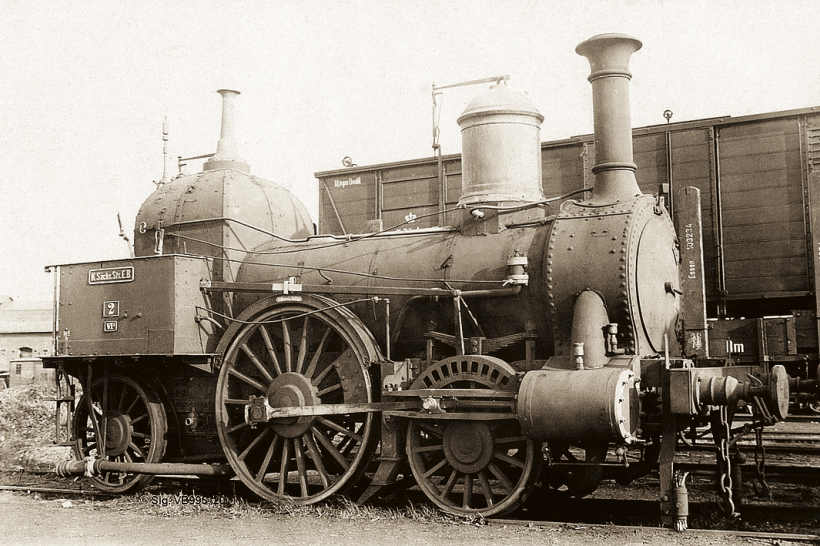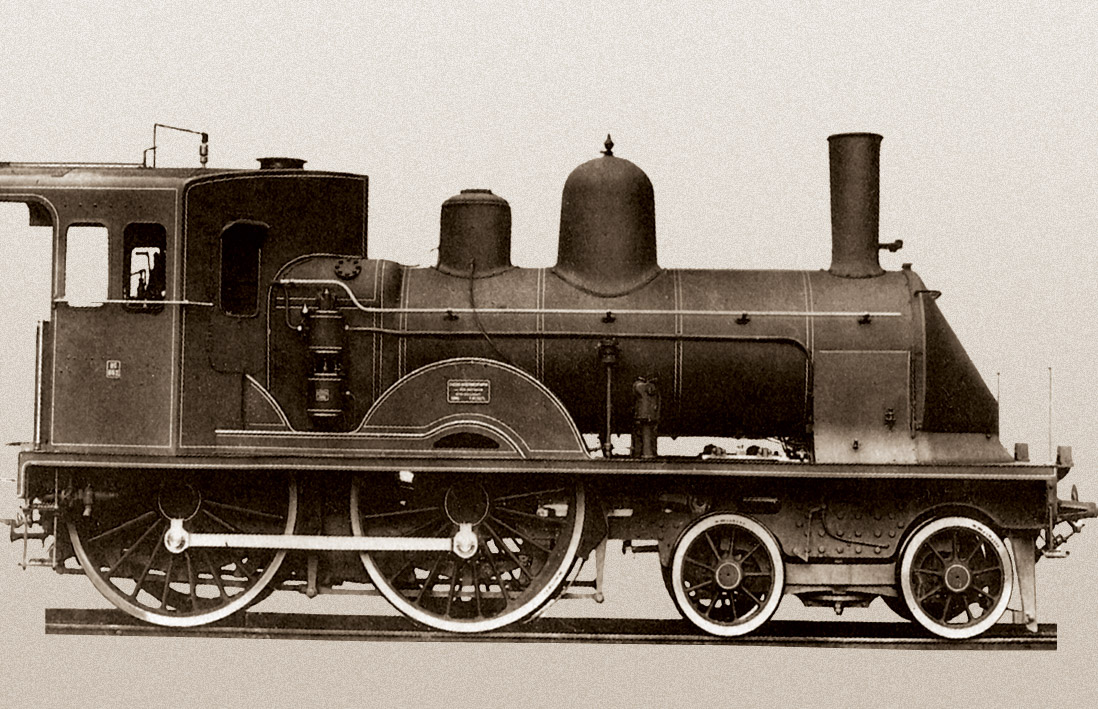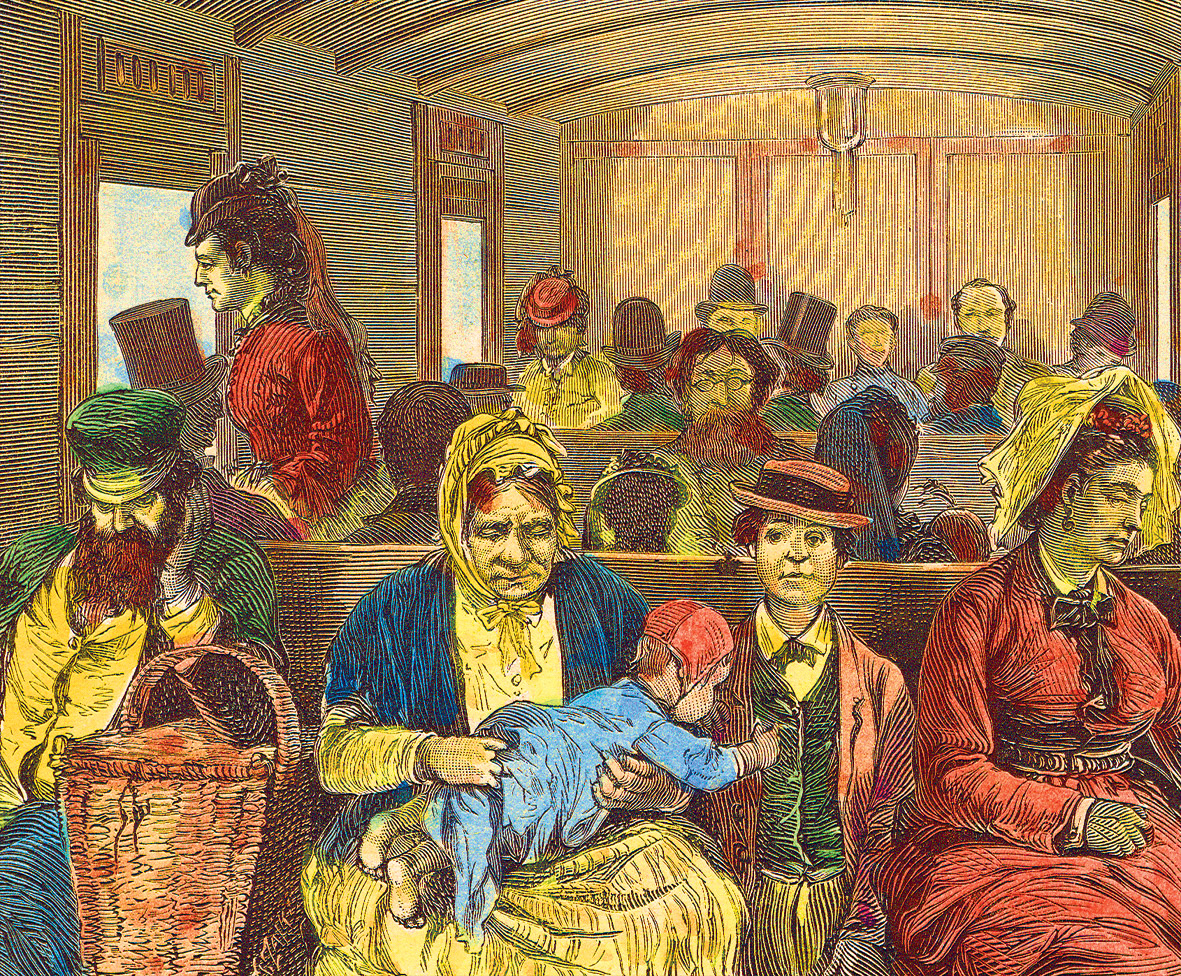
Niemiecki parowóz wyprodukowany przez firmę Borsig - lata 60. XIX w.
Historia kolei
9 listopada 2020

Niemiecki parowóz wyprodukowany przez firmę Borsig - lata 60. XIX w.
Rozwój kolei w Polsce
Na przełomie XVIII i XIX wieku, kiedy w świecie rozpoczynała pochód rewolucja przemysłowa, Polska utraciła niepodległość. W wyniku kolejnych rozbiorów 82% terytorium Rzeczypospolitej znalazło się pod panowaniem rosyjskim, 11% zagarnęła Austria, a 7% – Prusy. Podział ten przez następne 100 lat, kiedy rodziło się światowe kolejnictwo, miał decydujący wpływ na jego rozwój na ziemiach polskich.
Lokomotywa po ziemiach niemieckich sunie
Pruski Zarząd Górnictwa, na podstawie podpatrzonych angielskich konstrukcji maszyn parowych Matthew Murraya i Johna Blenkinsopa (z napędem przekazywanym na zębatkę ułożoną na zewnątrz toru), zlecił w 1816 roku budowę lokomotywy Johannowi Friedrichowi Krigarowi. Tak powstał pierwszy, zbudowany na kontynencie europejskim poza Anglią, parowóz, który zademonstrowano na pokazach w Berlinie. Następnie, po przewiezieniu do Chorzowa, miał pracować w Hucie Królewskiej. Niestety, ze względu na zawodny napęd zębaty, próba uruchomienia parowozu zakończyła się niepowodzeniem. Doświadczenia te przyczyniły się do zahamowania prac nad wdrażaniem techniki kolejowej. Poza tym zadłużone państwo pruskie nie było zainteresowane wprowadzeniem nowego środka transportu, finansując rozwój żeglugi śródlądowej i utrzymanie sieci dróg o utwardzanej nawierzchni. Dopiero w 1838 roku wydano ustawę o kolei, cedującą budowę i eksploatację nowych linii na koncesjonowane spółki kapitałowe. Rozwijająca się kolej stawała się wielkim pracodawcą, zapewniającym stałe pensje umożliwiające utrzymanie.
Kolej a żegluga
Istotny wpływ na prowadzenie linii kolejowych miał silny rozwój żeglugi śródlądowej. Przykładem była trasa kolei Wrocław-Opole-Kędzierzyn-Gliwice-Katowice-Mysłowice, poprowadzona celowo wzdłuż Odry, aby w ten sposób uruchomić alternatywny dla transportu rzecznego przewóz towarów, a także umożliwić szybki dowóz ładunków z portów do najbliższych stacji. Do budowy torów użyto szyn o szerokiej stopie, pochodzących z fabryk belgijskich i angielskich.
W 1842 roku jeden ze statków wiozących szyny z Anglii zatonął, wobec tego część z nich zamówiono interwencyjnie w działającej dopiero od kilku lat Hucie Laura w Siemianowicach Śląskich. Doskonała jakość wyprodukowanych elementów skłoniła inne towarzystwa z terenu Prus do składania kolejnych zamówień. W torach bocznicowych stosowano także tzw. szyny Brunela oraz szyny płaskie. Natomiast podkłady dębowe nienasycone zastąpiono wkrótce tańszymi, sosnowymi, nasączając je dla ochrony chlorkiem cynku (Rosja) albo olejem kreozotowym (Prusy).

Dwucylindrowy parowóz niemiecki - 1895 r.
Pierwsza linia kolejowa
Pociąg, złożony z ośmiu wagonów, prowadzony był przez parowóz „Silesia”, wyprodukowany w fabryce Sharp, Roberts & Co. Manchester. W pierwszym przejeździe, trwającym 42 minuty tam i 43 minuty jazdy powrotnej, wzięły udział 102 osoby. Tego dnia pociąg odbył cztery kursy.
Mieszkania dla drużników
Pierwotnie informacje o nadjeżdżającym pociągu były przekazywane dróżnikom za pomocą sygnałów podawanych przez dzwony elektryczne, instalowane na zewnątrz strażnic; w późniejszym okresie, za pomocą semaforów. Początkowo były one nastawiane ręcznie, na miejscu, następnie za pomocą pędni drutowych z pomieszczeń nastawni. Rok 1894 przyniósł wprowadzenie lepiej widocznego sygnału „wolna droga” w postaci zielonego światła, a sygnał „stój” stał się zasadniczym położeniem semafora. Do komunikacji kolejowej został wprowadzony również telegraf, a po 1876 roku telefon, zamek kluczowy do nastawiania zwrotnic i semaforów, oświetlana latarnia sygnałowa i zwrotnicowa. Poszczególne niemieckie spółki kolejowe posługiwały się odrębnymi regulaminami prowadzenia ruchu.
Para buch…
Parowozy sprowadzane były z Anglii do czasu, kiedy niemieckie fabryki opanowały technologię ich wytwarzania. Zasadniczo od początków produkcji stosowano nowoczesne kotły płomieniówkowe. W najstarszych konstrukcjach ramy podwozia, zwane ostojami, były zewnętrzne, wykonane z drewna, natomiast napęd z cylindrów przenoszono na oś z wykorbieniami w jej środkowej części. W latach 40. XIX wieku produkowano już parowozy z ostojami wewnętrznymi, cylindrami na zewnątrz ostoi i wiązarowymi mechanizmami napędowymi kół oraz układami rozrządu pary po bokach. Te ostatnie decydowały o jakości pracy i wykorzystaniu możliwości silnika parowego. Powstawały kolejno różne rozwiązania układu sterującego podawaniem pary do silników: Stephensona, Meyera, Goocha, Allana-Tricka i wreszcie, stosowane powszechnie od 1850 roku, Walschaertsa-Heusingera.
Pierwsze problemy i pierwsze innowacje
Mały rozstaw osi i niedoskonałe sprzęgi łańcuchowe powodowały niespokojną jazdę i dewastację toru. Zrodził się więc wynalazek urządzeń cięgłowych i zderzaków kauczukowych lub skórzanych, wypełnionych włosiem, zastąpionych później przez zderzaki tulejowe ze sprężyną stożkową. Rozstaw i wysokość zderzaków ponad główką szyny przyjęto stopniowo na wszystkich kolejach w ślad za wytycznymi Niemieckiego Związku Kolejowego. Był to następny, po zastosowaniu jednolitej szerokości toru, krok w kierunku wprowadzenia jednakowych norm technicznych.
Lokomotywa kołem się toczy
Koła, w zestawach kołowych także ulegały przemianom: od ramiennych kutych (złożonych z ośmiu segmentów odpowiednio wyginanych i zaklepywanych w całość), przez ramienne odlewane, stalowe, po tarczowe żeliwne i walcowane ze stali. Na czopach osi zestawów kołowych zakładano maźnice zawierające zbiornik na smar. W latach 90. XIX wieku weszły w użycie cztero- i sześcioosiowe wagony na wózkach systemu Pullmana, z korytarzem wzdłuż wagonu i przejściami w ścianach czołowych. Wózki typu „amerykańskiego” były wykonywane z drewna tekowego, obijanego blachą. Miały podwójne tzw. odsprężynowanie, które amortyzowało uderzenia od kół. To rozwiązanie zapewniało spokojny bieg wagonu, w przeciwieństwie do starych wózków typu pruskiego, bawarskiego, badeńskiego i saskiego. Ramy wykonywano następnie z profili stalowych, nitowanych, a w XX wieku – spawanych.
Konduktorzy hamulcowi
Kłopotliwe było hamowanie rozpędzonego składu. Pierwotnie hamulce instalowano jedynie w tendrach parowozów. Później wyposażano w nie koła napędowe, a w wagonach stosowano hamulce ręczne. Konduktorzy hamulcowi zajmowali miejsca na pomostach i w budkach hamulcowych w niektórych wagonach, które wstawiano w odpowiedniej kolejności w składzie pociągu. Na ustalone sygnały, dawane gwizdawką parowozu, uruchamiali oni hamulce. Wymagało to dużej uwagi i było uciążliwe, zwłaszcza zimą, ze względu na trudne warunki pracy. Stąd narodził się pomysł wprowadzenia automatycznych hamulców w całym składzie wagonów. Konstrukcje hamulców przeszły długą drogę: od linowych mechanicznych Haberleina, przez niesamoczynne (rozerwanie przewodu hamulcowego nie powodowało automatycznego hamowania pociągu), próżniowe Hardy’ego i Claytona, aż po samoczynne hamulce ciśnieniowe, zasilane sprężonym powietrzem, systemów: Westinghouse’a, Knorra, Kunze-Knorra, Hildebranda-Knorra, Dako i Oerlikona.
Ze względu na małą ładowność zwiększono długości wagonów poprzez wstawienie trzeciej osi pośrodku i skonstruowanie jej jako przesuwnej, aby drewniane ostoje wytrzymywały obciążenie ładunkiem. Dotyczyło to zarówno wagonów osobowych, jak i towarowych. Ostatecznie pojawiły się wózki wagonowe sytemu Diamonda dla wagonów towarowych oraz wózki o zróżnicowanej liczbie stopni odsprężynowania (2, 3 lub 4) dla wagonów osobowych.

Podróż w wagonie III klasy była znaczenie mniej komfortowa
Pierwsza, druga, trzecia, czwarta – klasy podróżowania
W zależności od wyposażenia, a więc i komfortu jazdy, wagony osobowe podzielono na cztery klasy. Stosowano konstrukcje z osobnymi drzwiami do każdego przedziału, umieszczonymi w bocznych ścianach (tzw. bokówki). Wagony I klasy miały ośmiomiejscowe przedziały, wyposażone w siedzenia z odłokietnikami obite miękką tkaniną, a także skórą, ściany wyłożone tkaninami i szyby w oknach. Wagony II klasy mieściły w przedziałach po 10 osób. Do lat 70. XIX wieku obydwie klasy były ogrzewane pojemnikami z gorącym piaskiem, butlami z wodą, później piecykami brykietowymi, wstawianymi pod siedzenia, a od lat 80. XX wieku – grzejnikami zasilanymi parą z parowozów. Niektóre wagony miały piece na węgiel i koks. Klasę III wyposażono w twarde ławki dla 10 osób i początkowo nieoszklone okna. Wagony klasy IV najpierw budowano jako odkryte, z drewnianymi ławkami w poprzek wagonu, później montowano zadaszenie, by w 1887 roku tę klasę zlikwidować. Powróciła ona z krytymi wagonami na początku XX wieku w odpowiedzi na zainteresowanie podróżnych tanimi przewozami.
Rozwijała się również technika oświetlenia przedziałów: od świec, przez lampki olejowe, oświetlenie naftowe i lampy na gaz świetlny, zasilane ze zbiorników umieszczonych pod wagonami. Zanim skonstruowano centralne instalacje zasilające lampy gazem, wymianę świec, uzupełnianie oleju bądź nafty oraz zapalanie lamp przeprowadzało się z dachu wagonu. Zajmowali się tym „zapalacze” przechodzący po dachach wzdłuż składu pociągu. Zupełnie inaczej wyglądał rozwój kolei z pozostałych zaborach.